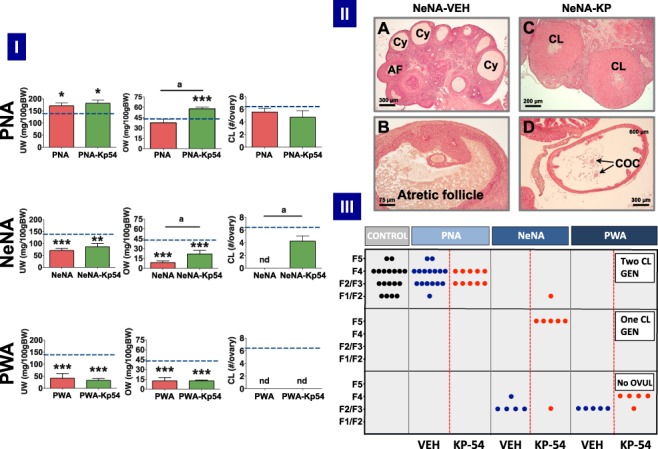Figure 6.

Ovarian responses to KP-54 in the three preclinical rat models of PCOS. In panel I, UW and OW, as well as the number of fresh CL per ovary, after 11-day treatment with KP-54 or vehicle are shown from the three preclinical models of PCOS (PNA, NeNA and PWA); dotted lines indicate reference OW, UW and CL in control (non-androgenized) adult female rats. Data are presented as mean ± SEM and were analyzed by ANOVA followed by Student–Newman–Keuls multiple range tests (*P < 0.05, **P < 0.01, ***P < 0.001 versus control rats; aP < 0.01 versus PNA rats treated with Vehicle). In panel II, representative images of ovarian histology of adult NeNA rats treated as adults with vehicle (A, B) or KP-54 (C, D). The presence of CL, Cy, atrophic follicles (AF) and cumulus oocyte complexes (COCs) is indicated. Note that while NeNA rats treated with vehicle failed to show CL (as index of anovulation), KP-54 administration to NeNA rats rescued ovulation, as denoted by the appearance of CL and COC. Scale bars are as follows: A (300 μm); B (75 μm); C (200 μm); and D (300 μm). In panel III, scoring of follicular maturation and ovulatory status in PNA, NeNA and PWA rats, following treatment as adults with either vehicle (blue dots) or KP-54 (red dots), is presented. Note that each dot represents the score of individual ovaries. Depending on initial morphometric data and optimally fixed tissue availability, ovaries from 5–10 independent animals were studied per model. Control, non-androgenized rats are included (black dots) for reference purposes. Analyses were conducted in ovarian samples obtained after completion of the 11-day period of treatment with KP-54 or vehicle. Scoring of follicular maturation was based on the identification of the most advanced stage of large growing follicles, divided into these classes: F1 (275–350 μm), F2 (351–400 μm), F3 (401–450 μm), F4 (451–575 μm) and F5 (>575 μm). The presence of one or two generations (GEN) of corpora lutea denoted the occurrence of one or two ovulatory cycles.
